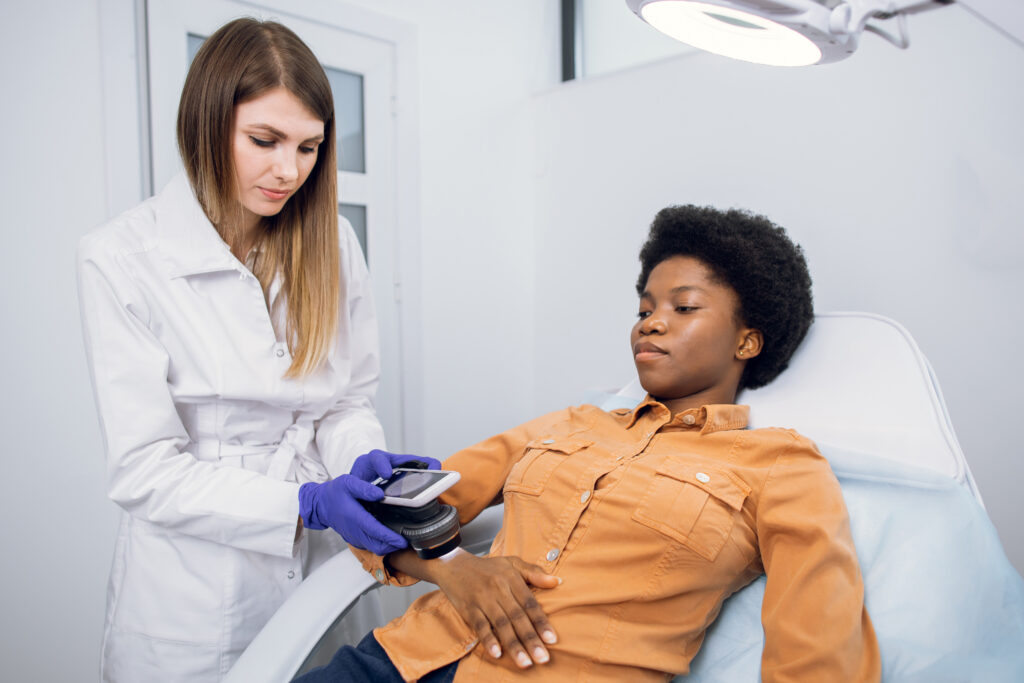Skin is the largest organ of the human body—so large that it encapsulates every system within it. But when was the last time you checked on your skin, especially during these hot summer months?
Skin cancer, its types, and associated treatments have been circulating a lot of attention lately, and for good reason. According to recent statistics, 1 in 5 Americans will develop skin cancer by age 70. With a starking 20% chance of catching the deadly disease, learning the facts about skin cancer treatment, diagnosis, testing, and the different types is vital. Understand the nuances so you can take the proactive steps necessary for prevention, early detection, and informed decision-making.
Types of Skin Cancer
1. Basal Cell Carcinoma (BCC)
Basal cell carcinoma (BCC) is the most common form of skin cancer, constituting around 80% of all cases. Typically forming in sun-exposed areas like the face, neck, and hands, BCC manifests as a pearly bump or pinkish patch. Thinking it may be just a superficial blemish initially, it accelerates into a bleeding, crusty, or ulcer-ridden lesion. Despite its slow growth and the fact that it rarely metastasizes, the only way to prevent local damage is through early detection. If formed, treatments like surgical removal, cryotherapy, and topical medications can combat it.
2. Squamous Cell Carcinoma (SCC)
Squamous cell carcinoma (SCC) is the second most prevalent skin cancer, presenting in 20% of all cases. Like BCC, it appears through sun exposure on the face, ears, and hands. Its appearance varies, from red nodules to scaly patches. The difference between SCC and BCC is that SCC can spread to other body parts instead of staying localized to one spot. Detecting and treating it early on can yield high cure rates, achieved by surgical excision, Mohs surgery, cryotherapy, or radiation therapy.
3. Melanoma
The American Cancer Society predicts this year that an estimated 97,610 new melanomas will be diagnosed (about 58,120 in men and 39,490 in women), and around 7,990 people are expected to die of melanoma (about 5,420 men and 2,570 women). Such figures suggest that melanoma is the most aggressive skin cancer type.
The skin cancer variant derives from melanocytes, the pigment-producing skin cells. Though representing a smaller percentage of skin cancers, melanoma has the potential to spread quickly to other organs if not detected early. The probability of its development increases with sun exposure; regardless, it can form anywhere despite being unexposed to sunlight.
Melanoma appears as irregular, multi-colored moles that grow and evolve over time. To spot the signs, follow the ABCDE rule. This proactive measure is well-known in the medical world for systemizing the warning signs for malignant melanoma (MM)—an acronym for Asymmetrical, Border, Color, Diameter, and Evolving.
The process involves identifying skin growths like moles for an asymmetrical makeup, uneven borders, dark, black, or multi-colored surface, diameter greater than 6 mm, and evolution in shape, color, and size. If at least one of these variables is a definitive no, you should be safe from melanoma. Surgery, chemotherapy, radiation therapy, immunotherapy, and targeted therapy are all potential options when treatments are needed.
Prevention
UV rays, a type of imperceptible energy emitted by the sun, are the most likely cause of any skin cancer. Everyone should adopt precautions like reducing direct midday sun exposure, seeking shaded areas, and using umbrellas, hats, and sunglasses with 99% UV ray blockage to mitigate the harmful effects. Most importantly, remember to wear sunscreen with an SPF of at least 15.
Skin Cancer Diagnosis and Testing
To perform skin cancer testing and diagnosis effectively, perform regular self-examinations and professional skin checks and detect changes in moles, lesions, or spots. If any concerns arise, seek medical help from an experienced dermatologist. They use diagnostic methods like dermoscopy, skin biopsy, and advanced imaging techniques to accurately pinpoint skin cancer types and stages.
At AMARA MD, leading dermatologist Joshua Newman, M.D., and physician assistant Shannon Bednarz, PA-C, perform Mohs Micrographic Surgery to remove skin cancer precisely. The AMARA dermatology team offers various treatment options and medical-grade products for both standard and complex dermatologic conditions—so you can achieve the healthy, smooth complexion you deserve.
Don’t wait for skin cancer to present itself. Book your appointment with the Venice, FL, experts at AMARA today.
**While we strive to provide accurate and up-to-date information, medical knowledge is constantly evolving, and new research may change the nature of certain conditions. Please remember to consult with a healthcare professional or dermatologist for proper diagnosis, treatment, and guidance regarding skin cancer or any other medical condition.**



